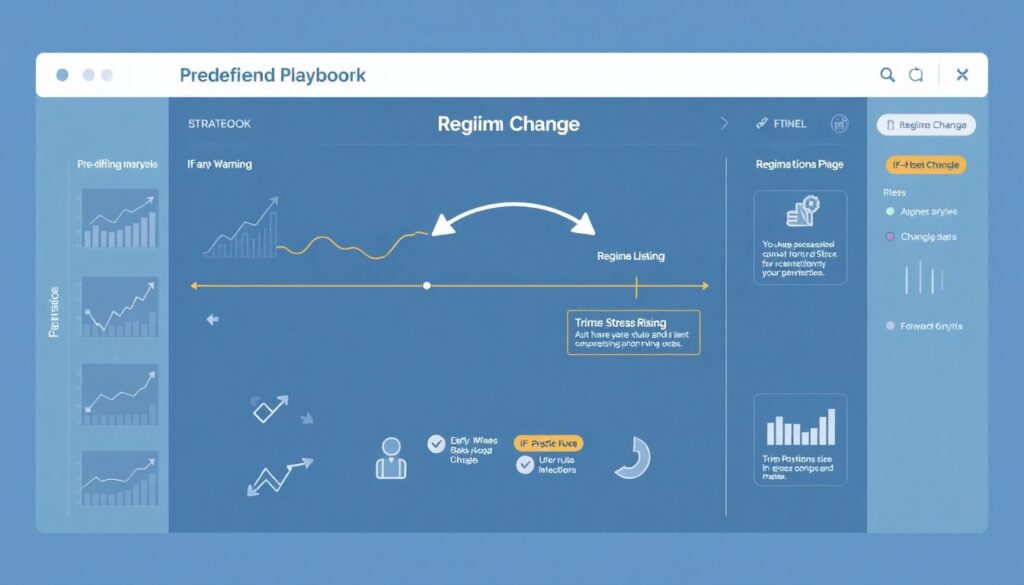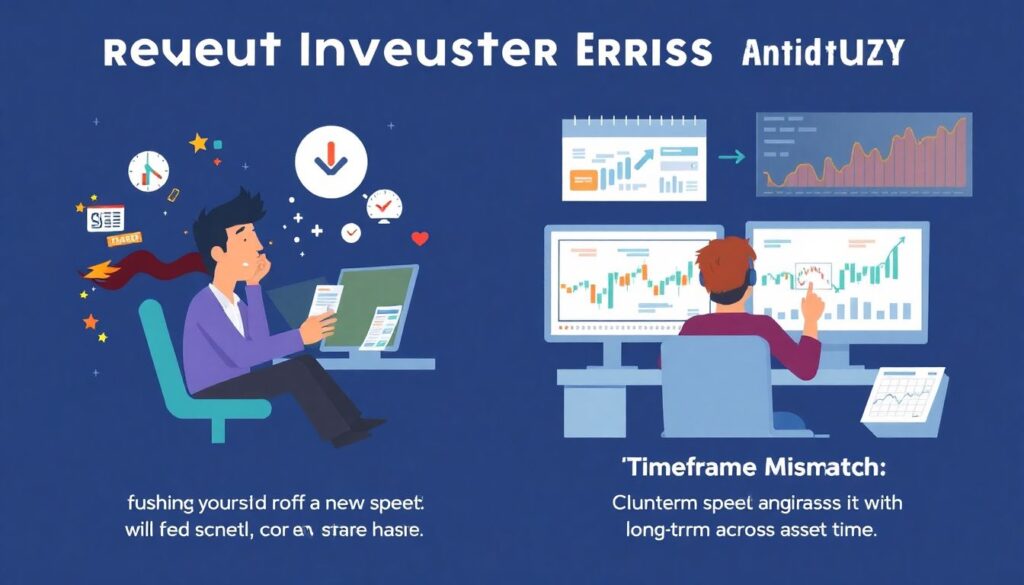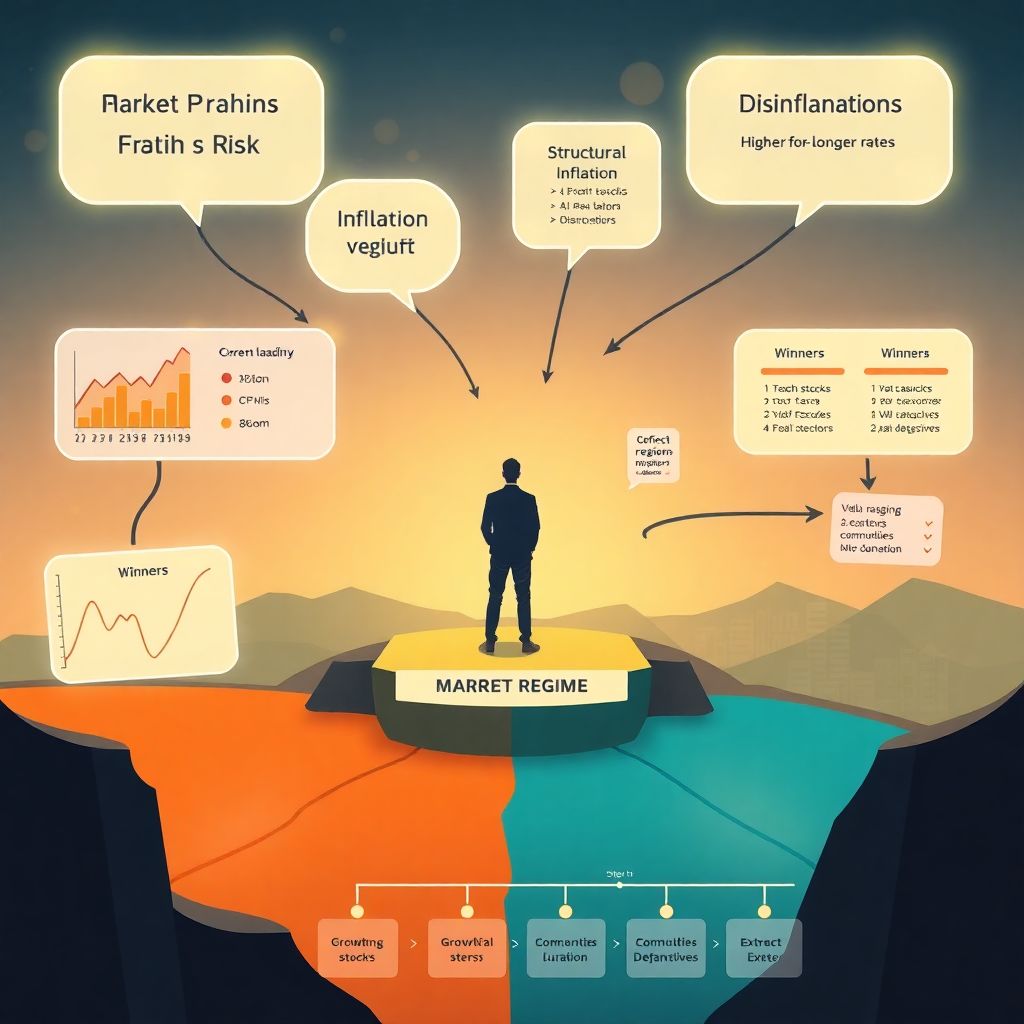Why Narratives Matter More Than Ever
Most people look at charts, indicators, and news headlines. But what actually moves prices over months and years are *stories* the market collectively believes: inflation will stay high, AI will eat the world, deglobalization is permanent, central banks will always bail us out, and so on.
Those stories are called narratives, and they define the market regime you’re trading in: risk-on vs risk-off, inflation vs disinflation, growth vs value, duration-friendly vs duration-hostile, etc. If you ignore narratives, you’re playing a game with half the rules hidden.
In this guide we’ll connect narratives and market transitions to a concrete, step‑by‑step approach you can use to anticipate the next regime and adjust your portfolio instead of reacting late.
—
Step 1: Define the Current Market Regime in Plain Terms
Before you try to predict the future, you need a clean description of “now.” A market regime is just a label for a bundle of conditions: growth, inflation, policy, liquidity, volatility, and leadership in the stock market.
Keep it simple. Describe the regime with a few binary (or near-binary) choices:
1. Growth: accelerating / decelerating
2. Inflation: rising / falling / stable
3. Monetary policy: tightening / easing / on hold
4. Liquidity: abundant / tightening
5. Volatility: low and compressed / high and expanding
6. Equity leadership: growth / value / defensives / cyclicals / commodities
Short version: “We are in a disinflationary, liquidity-supportive regime with low volatility and growth leadership” is vastly more useful than “the market feels toppy.”
Practical check:
Look at a few objective proxies:
– Growth: PMIs (above/below 50), earnings revisions, leading indicators
– Inflation: CPI trend, breakeven rates
– Policy: rate change trajectory, balance sheet (QE vs QT)
– Volatility: VIX level and trend
– Leadership: relative performance ratios (e.g., QQQ/SPY, XLE/SPY, IWD/IWF)
Common beginner mistake:
Mixing *regime* with *valuation opinion*. “Stocks are expensive” is not a regime; it’s a view. You want state of the system, not your feelings about price.
—
Step 2: Extract the Dominant Narrative Behind That Regime
Once you know the regime, ask: *What story is the market telling itself to justify this configuration of prices?* That’s the dominant narrative.
Examples:
– “Soft landing is coming; central banks nailed it.”
– “Inflation is structural; commodities and real assets must reprice higher.”
– “AI-driven productivity boom will rescue margins and growth.”
– “Deleveraging and higher-for-longer rates cap equity multiples.”
This is where narrative driven investing strategy for stock market decisions come from, whether people admit it or not. Fundamentals matter, but their *interpretation* is narrative‑driven.
How to surface the narrative in practice:
– Read central bank statements and Q&A, not just headlines
– Scan earnings call transcripts of megacaps and key cyclicals
– Track language in major financial media: what phrases keep repeating?
– Note what risks are dismissed as “already priced in” vs treated as existential
Short test: if you had to summarize why the market is comfortable holding current prices in one sentence, what would it be? That’s your actionable narrative.
—
Step 3: Map Which Assets Are “Narrative Winners” and “Narrative Losers”
Narratives don’t hit all assets equally. Each story creates beneficiaries and casualties. You want to map that explicitly.
For each major narrative, write down:
– Who needs this narrative to be true? (e.g., long-duration growth stocks, leveraged credit, EM FX)
– Who is implicitly short the narrative? (e.g., long volatility, defensives, gold in some cases)
Example:
Narrative: “Rates will fall soon; disinflation without hard landing.”
– Winners: long-duration growth, unprofitable tech, REITs, long-dated IG credit
– Losers: short-duration value, pure inflation hedges, some defensive sectors
This mapping is foundational for any market regime change investing strategy. The day the narrative cracks, the winners become vulnerable, and the ignored losers often become the new leadership.
Beginner tip:
Don’t obsess over exotic instruments. Start with broad ETFs and sectors: growth vs value, cyclicals vs defensives, nominal bonds vs TIPS, commodities vs stocks.
—
Step 4: Identify Narrative Stress Signals (When the Story Stops Fitting)
Narratives usually break *slowly*, then all at once. Your edge is catching the slow part. You’re watching for narrative stress: data and price action that contradict the story, but that the majority is still rationalizing away.
Key stress signals:
1. Data divergence:
– The narrative says “inflation is under control,” but sticky inflation or wage data keep surprising to the upside.
– Or the story says “growth is robust,” while leading indicators and new orders roll over.
2. Cross-asset disagreement:
– Equities are euphoric while credit spreads quietly widen.
– Commodities price in recession while indexes hit new highs.
3. Price action vs news asymmetry:
– “Good” news stops pushing prices higher.
– “Bad” news starts causing outsized drawdowns.
Short, practical exercise:
Once a month, write: “If the current narrative were *wrong*, what would I expect to see first in the data and in prices?” Then actively look for that.
Big mistake to avoid:
Waiting for the narrative to be officially declared “dead” in mainstream media. By that time, the regime shift is well underway and most of the repricing has happened.
—
Step 5: Use Simple Quantitative Models to Predict Regime Shifts
You don’t need PhD-level infrastructure, but some structure helps avoid emotional decisions. You can build quantitative models to predict market regime shifts with surprisingly simple ingredients.
At a basic level, you’re trying to classify:
– Risk-on vs risk-off
– Inflationary vs disinflationary
– Tight vs loose financial conditions
A practical DIY setup:
1. Choose a small set of indicators for each dimension (growth, inflation, policy, volatility).
2. Normalize them (z-scores or percentile ranks over the last, say, 5–10 years).
3. Define bands: low / medium / high.
4. When several dimensions cross thresholds together, tag a potential regime transition.
Example (very simplified):
– If PMIs drop below 50, credit spreads widen > X bps from lows, and VIX moves above 20 and stays there, you flag a rising probability of risk-off regime.
– If breakeven inflation and commodities both break multi-month highs while real yields stay low, you flag possible shift to inflationary regime.
You can implement this in a spreadsheet. Keep rules explicit and stable for at least one full cycle; constantly tweaking is just overfitting your fears.
Beginner advice:
Start with a *binary* framework (risk-on vs risk-off) before building multi-regime complexity. Complexity without data discipline is a recipe for confusion.
—
Step 6: Build a Stepwise Playbook for Portfolio Changes

Knowing a regime might change is useless if you don’t have a pre‑defined playbook. You want an if-then structure that governs how you adjust.
For example, for how to invest ahead of economic cycle transitions, you might define:
1. Early warning phase (regime stress rising):
– Trim position sizes in the most narrative-exposed assets.
– Increase diversification across styles and sectors.
– Begin accumulating hedges (options, defensive sectors, a bit more cash).
2. Transition phase (regime break confirmed by multiple signals):
– Rotate from winners to future beneficiaries of the new narrative.
– Shorten or lengthen duration depending on rate/inflation shift.
– Adjust geographic exposure (e.g., from DM to EM or vice versa).
3. New regime established:
– Concentrate positions back into assets aligned with the new narrative.
– Reduce hedges and normalize cash levels.
– Recalibrate risk limits to new volatility environment.
Keep size changes gradual. Think in increments (e.g., 5–10% of portfolio) rather than all-in/all-out swings.
Common pitfall:
Treating the first sign of stress as a full regime shift and flipping the portfolio overnight. Regime change is probabilistic; scale in as evidence accumulates.
—
Step 7: Asset Allocation for Changing Regimes (Make It Concrete)
Let’s make “regime-aware” allocation more tangible. There’s no single best asset allocation for changing market regimes, but you can build a flex framework.
A simple way:
– Define a core allocation that you keep through cycles (e.g., global equity + bonds + some real assets).
– Add regime tilts of limited size (say ±10–25% around the core) based on your regime and narrative analysis.
Illustrative logic:
– Disinflation, falling rates, risk-on: tilt toward growth, long-duration bonds, quality credit; lower commodities.
– Inflationary, rising real yields: tilt toward value, commodities, TIPS, shorter-duration credit; cut long-duration growth.
– Late-cycle, tightening liquidity: increase cash, defensives, quality; decrease leverage and speculative growth.
– Early recovery: add cyclicals, small caps, EM; gradually reduce ultra-defensive exposure.
Keep a written matrix that forces you to express: “If regime = X, my tilts = Y.” That creates discipline and a reference when you’re tempted to improvise under stress.
Beginner reminder:
Don’t abandon diversification. Regime tilts should *tilt*, not completely override, your long-term risk profile.
—
Step 8: Blend Narrative and Quant – Don’t Marry Either
It’s tempting to become either a pure storyteller (“macro tourist”) or a pure quant (“my model says”). In practice, robust regime investing uses both.
A balanced workflow:
1. Start with data → define regime and monitor quantitative triggers.
2. Interpret what story the market is telling to justify prevailing prices.
3. Check for inconsistencies between story and data/price action.
4. When both your narrative analysis and quantitative regime model flag rising transition odds, act.
5. When they diverge, scale position sizes down and prioritize risk management over strong directional bets.
This is the core of a narrative driven investing strategy for stock market that is still grounded in evidence, not vibes.
Red flag for yourself:
If you keep saying “the market is wrong” for months while your P&L bleeds, you’re not practicing narrative + quant; you’re practicing stubbornness.
—
Step 9: Common Mistakes When Trading Regime Shifts

Let’s isolate frequent errors, especially painful for newer investors:
1. Confusing speed with conviction
– Overreacting to every data print as a “regime change.”
– Antidote: require *clusters* of signals across assets and time.
2. Timeframe mismatch
– Thinking in intraday terms while dealing with structural narratives (inflation, deglobalization) that play out over years.
– Antidote: choose your primary timeframe (swing, position, long-term) and size trades accordingly.
3. Overfitting to the last crisis
– Treating every wobble as 2008 or 2020.
– Antidote: keep a library of multiple past regimes, not just the scariest one you lived through.
4. All-in regime bets
– Concentrating the entire portfolio on one scenario.
– Antidote: build base, bull, and bear narratives and size them proportionally to probability and evidence.
5. Ignoring liquidity and positioning
– Betting on “obvious” regimes without considering that everyone else is already there (crowded trade).
– Antidote: pay attention to flows, positioning reports, and how violently markets move on modest news.
—
Step 10: A Simple Implementation Plan for Beginners

To make this actionable, here’s a workable starter process you can follow each month:
1. Regime snapshot (30–60 minutes)
– Note current readings for growth, inflation, policy, volatility, and market leadership.
– Write a one-sentence description of the current regime.
2. Narrative check (30 minutes)
– Summarize the dominant market story in 2–3 bullet points.
– List 2–3 potential “anti-narratives” that could replace it.
3. Stress scan (30 minutes)
– Look for data and price action contradicting the dominant story.
– Note whether stress is isolated or cross-asset.
4. Portfolio alignment (30–60 minutes)
– Check how much of your portfolio benefits from the current narrative, and how much benefits from the main alternative.
– Adjust tilts slightly (5–10%) if evidence for a transition has strengthened.
5. Risk rules (once, then periodic review)
– Set maximum allocation to any single narrative or regime thesis.
– Define drawdown or volatility thresholds that force you to reduce risk regardless of your narrative confidence.
Short version: treat regime and narrative work as a *routine process*, not something you do only in “crisis” headlines.
—
Final Thoughts: Thinking Like a Regime Investor
If you start to see markets as sequences of regimes, each powered by a story that eventually overreaches and breaks, your behavior changes:
– You ask “what regime are we in?” before asking “is this stock cheap?”
– You build a market regime change investing strategy instead of hoping your favorite style always works.
– You think in probabilities and transitions, not permanent states.
– You adjust *exposure* and *composition* as narratives evolve, instead of clinging to one worldview.
You don’t need to predict every turn of the economic cycle. But if you systematically track narratives, combine them with structured indicators, and pre-define how you’ll shift allocation, you’ll already be far ahead of most investors who only react when the headlines scream “new era.”

